If you abandon the game instead of resigning on chess.com you should lose double the elo.
25.10.2025 02:04 — 👍 0 🔁 0 💬 0 📌 0
I sacrificed, THE ROOOOOOOK! #chess is there any kind of chess BlueSky community? Thinking of doing a 100 days of chess type of thing
16.10.2025 14:39 — 👍 1 🔁 2 💬 0 📌 0

Chess game from chess.com with a rook sacrifice
And he sacrifices THE ROOOOOOOOOOK
22.08.2025 19:04 — 👍 1 🔁 0 💬 0 📌 0
The Ruy Lopez opening is so annoying to play against that I am just going to start using it myself. #chess
15.08.2025 15:57 — 👍 2 🔁 0 💬 0 📌 0
What was your favorite early clas NOT in your eventual major. Mine was Ethnomusicology: an introduction to folk music.
28.07.2025 13:14 — 👍 585 🔁 43 💬 456 📌 985
I am wondering what Natalie Wynn (contrapoints) could’ve said about Israel that wouldn’t have resulted in an internet dogpile.
11.07.2025 01:47 — 👍 5 🔁 1 💬 3 📌 0
There are only three political positions in America today
1) I like the fascism
2) I'll acquiesce to the fascism (reasons for this one vary: cowardice, access, denial, misguidedly thinking that acquiescence is savvy, etc)
3) I oppose the fascism
The rest is details
28.06.2025 18:10 — 👍 20002 🔁 5135 💬 453 📌 284
Ohio State announces it is now a joke.
08.06.2025 20:53 — 👍 3 🔁 0 💬 0 📌 0
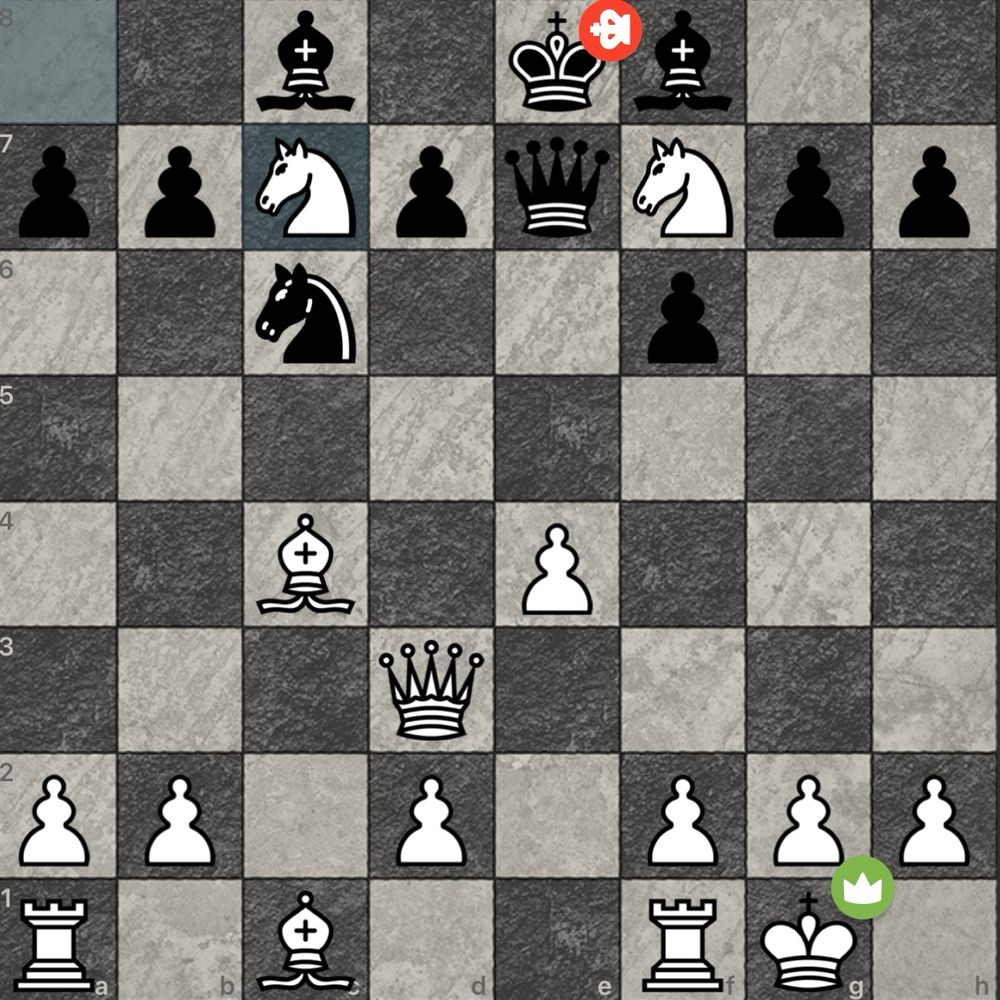
A chessboard from chess.com showing 2 knights giving checkmate
Don’t ask my elo but just know I’m way prouder of this checkmate than I should be
20.04.2025 14:53 — 👍 2 🔁 0 💬 0 📌 0
If equal temperament has 1,000,000 haters, I am one of them.
If equal temperament has 1 hater, it is me.
If equal temperament has 0 haters, I am dead.
15.04.2025 22:07 — 👍 4 🔁 0 💬 0 📌 0
I think it’s time to reverse the curse everyone, we need to go back before the early modern era and set things right, I will be attempting to turn back time by playing the lute and using only 16th century chess openings, do your part.
09.03.2025 00:22 — 👍 4 🔁 0 💬 0 📌 0

The dog in question, 13 year old Merlin, a lab-hound mix.
Something that surprises me about having a 13 year old dog is that I have to tell him to slow down so he doesn’t get hurt. A truly bizarre combination of geriatric and toddler behavior
01.03.2025 22:49 — 👍 3 🔁 0 💬 0 📌 0
Every time I see Musk’s name in media it should be formatted like this
Elon Musk, who recently gave 2 Nazi salutes, …
26.02.2025 13:43 — 👍 2 🔁 0 💬 0 📌 0
“Clap on 2&4 never on 1&3!”
Hey. Stop clapping! You’re bothering me
24.02.2025 00:02 — 👍 0 🔁 0 💬 0 📌 0
Love those groovy covers! And that album
16.02.2025 01:30 — 👍 2 🔁 0 💬 0 📌 0
Posting like: who’s minority leader of the house, I would like a word with them!
04.02.2025 14:33 — 👍 0 🔁 0 💬 0 📌 0
I just finished Neal Stephenson’s Baroque Cycle. I liked it a lot but mostly I just want to say that I finished it because it’s almost 3000 pages long.
23.01.2025 16:47 — 👍 2 🔁 0 💬 0 📌 0

Look again at that dot. That's here. That's home. That's us. On it everyone you love, everyone you know, everyone you ever heard of, every human being who ever was, lived out their lives. The aggregate of our joy and suffering, thousands of confident religions, ideologies, and economic doctrines, every hunter and forager, every hero and coward, every creator and destroyer of civilization, every king and peasant, every young couple in love, every mother and father, hopeful child, inventor and explorer, every teacher of morals, every corrupt politician, every "superstar," every "supreme leader," every saint and sinner in the history of our species lived there--on a mote of dust suspended in a sunbeam.
The Earth is a very small stage in a vast cosmic arena. Think of the rivers of blood spilled by all those generals and emperors so that, in glory and triumph, they could become the momentary masters of a fraction of a dot. Think of the endless cruelties visited by the inhabitants of one corner of this pixel on the scarcely distinguishable inhabitants of some other corner, how frequent their misunderstandings, how eager they are to kill one another, how fervent their hatreds.
Our posturings, our imagined self-importance, the delusion that we have some privileged position in the Universe, are challenged by this point of pale light. Our planet is a lonely speck in the great enveloping cosmic dark. In our obscurity, in all this vastness, there is no hint that help will come from elsewhere to save us from ourselves.
The Earth is the only world known so far to harbor life. There is nowhere else, at least in the near future, to which our species could migrate. Visit, yes. Settle, not yet. Like it or not, for the moment the Earth is where we make our stand.
…To me, it underscores our responsibility to deal more kindly with one another, and to preserve and cherish the pale blue dot, the only home we've ever known.
— Carl Sagan, Pale Blue Dot, 1994
That’s here. That’s home. That’s us.
23.01.2025 03:39 — 👍 2 🔁 0 💬 0 📌 0

assignedmedia - Twitch
assignedmedia streams live on Twitch! Check out their videos, sign up to chat, and join their community.
EXCITING ANNOUNCEMENT:
Assigned Media will be doing our first ever live Twitch stream this Monday.
Our trans journalists are counterprogramming the Trump inauguration. They'll play games, goof off, answer questions, and update you on the news, occasionally.
We've even got a special guest!
18.01.2025 12:53 — 👍 219 🔁 70 💬 3 📌 5
Luckily it’s easy to find lots of info that’s not conveniently threaded together based on the book, the podcast Historiansplaining has several eps that cover various topics in early modern Europe and they’re a favorite.
13.01.2025 15:30 — 👍 0 🔁 0 💬 0 📌 0
Halfway through the final novel of Neal Stephenson’s baroque cycle, and/or halfway through the 7th of 8 novels of the BC. Has anyone read this? I love it. I wish someone with actual credentials would do a historical series unpacking the history of the era the book is focused on.
13.01.2025 15:29 — 👍 0 🔁 0 💬 1 📌 0
Reporting to you from the other side of the rag, Glickman crushed it. it also seems I may have gotten the year wrong, the label on the LP says 1978 but I assume it must be the year of reissue as Stokowski died in 77. He was active til the end but was exclusive with Columbia beginning 76.
11.01.2025 23:32 — 👍 2 🔁 0 💬 0 📌 0
![Stravinsky Histoire du Soldat [A Soldier’s Tale] ensemble info in alt text of next picture, album art depicts the soldier playing his violin attended by his gf, while the devil sneaks up behind him](https://cdn.bsky.app/img/feed_thumbnail/plain/did:plc:ab4byw6tdxki7lbbc6yzvr3g/bafkreigvjrpqh4dhoknfw5onfsspgzn7lrqy3am4r5ssimb464bnyuxaaq@jpeg)
Stravinsky Histoire du Soldat [A Soldier’s Tale] ensemble info in alt text of next picture, album art depicts the soldier playing his violin attended by his gf, while the devil sneaks up behind him
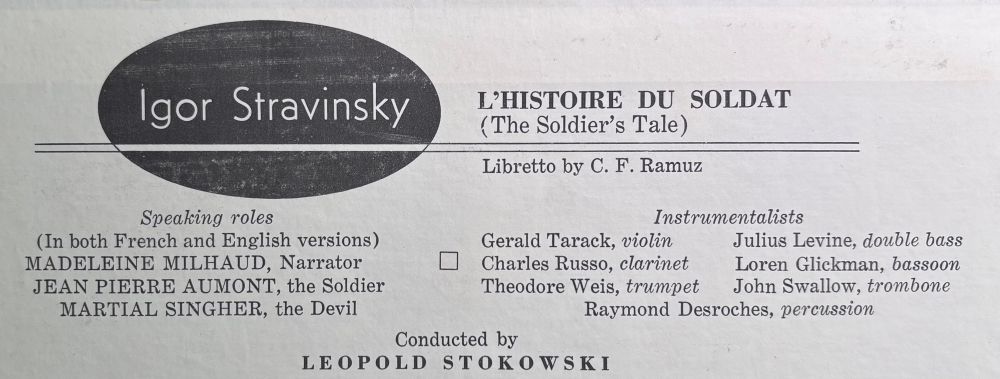
Igor Stravinsky
Speaking roles
(In both French and English versions)
MADELEINE MILHAUD, Narrator
JEAN PIERRE AUMONT, the Soldier
MARTIAL SINGHER, the Devil
L'HISTOIRE DU SOLDAT
(The Soldier's Tale)
Libretto by C. F. Ramuz
Instrumentalists
Gerald Tarack, violin
Julius Levine, double bass
Charles Russo, clarinet
Loren Glickman, bassoon
Theodore Weis, trumpet
John Swallow, trombone
Raymond Desroches, percussion
Conducted by
LEOPOLD STOKOWSKI
Listening to a 1978 recording of Histoire du Soldat conducted by stokowski, probably one of my all time favorite pieces and if you’re a bassoonist incredibly fun to play (and wickedly hard!). Loren Glickman is crushing it on this record-although I haven’t gotten to the ragtime yet…
11.01.2025 23:03 — 👍 5 🔁 0 💬 1 📌 0
I say we rename Beethoven’s Große Fugue as one of the following
Beethoven’s Fat Ass Fugue
Big ‘n’ Juicy Fugue
Oh that fugue? She thicc.
Gyat-DAMN that fugue!
Dat fugue doe
Big Ol’ Fugue
Who’s with me!?
08.01.2025 00:06 — 👍 5 🔁 0 💬 0 📌 0
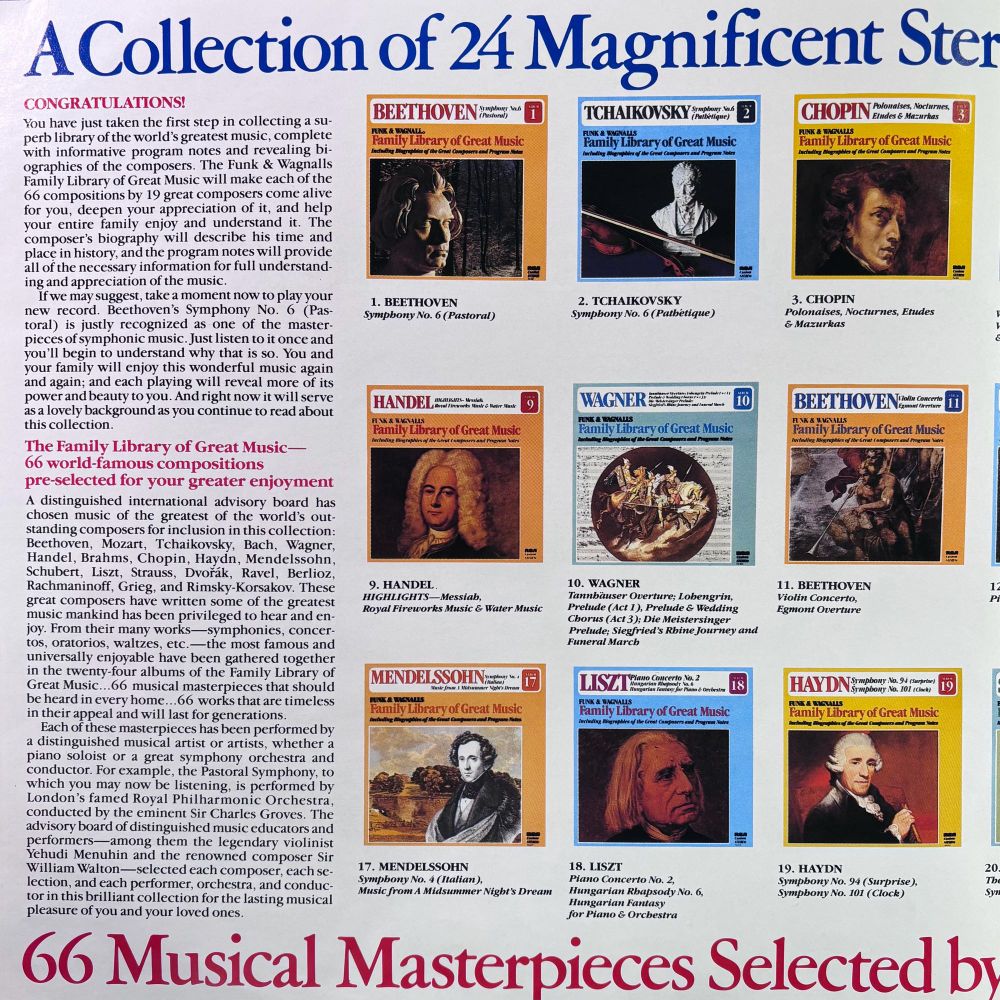
Top text of pg 1-2: A collection of 24 Magnificent Stereo Albums Every Home Should Have
Page 1 of an included advertisement for the library which includes the selection process and pictures of the 24 albums

Bottom text from pg 1-2: 66 Musical Masterpieces Selected by Experts for your Family’s Enjoyment
Page 2 of the ad for the family library, continued pictures of the included albums
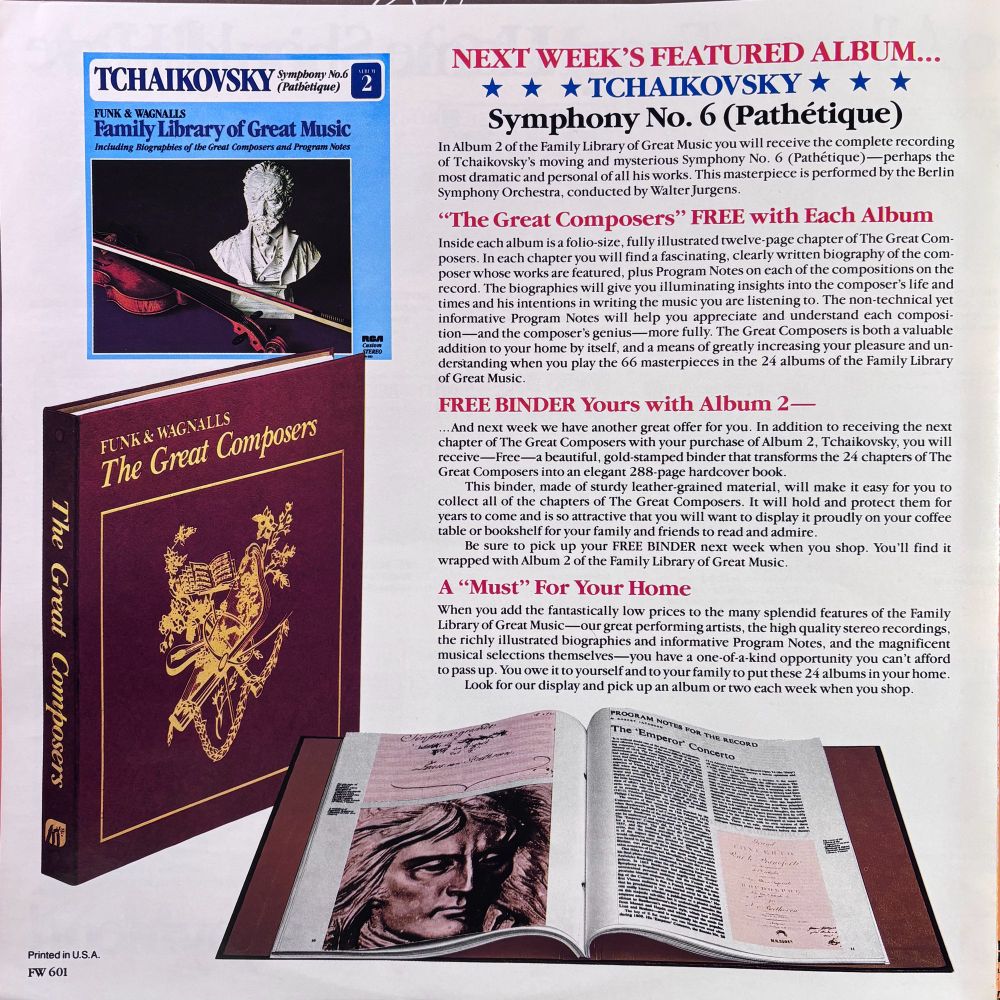
Back page of the advert, includes the image of a wonderfully stylish binder to house all the included biographies, free with your purchase of album 2!
Some more images from inside the included brochure, I’m definitely going to have to track down this exclusive binder to store all the included composer biographies in
10.12.2024 21:18 — 👍 0 🔁 0 💬 0 📌 0
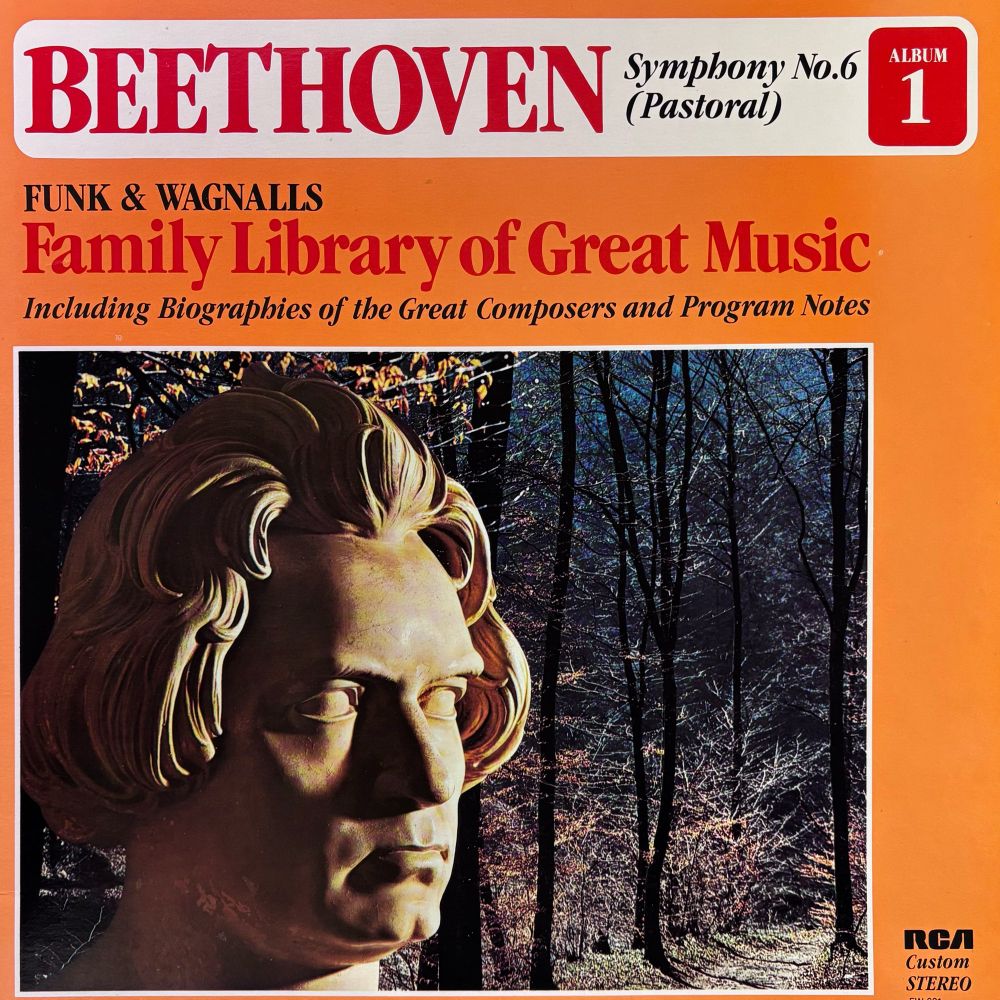
Funk and Wagnalls Family Library of Great Music, album 1. Beethoven’s pathetique. Played by the RPO and conducted by Charles Grove.

Reverse of the album. The collection is from 1966 originally, but this was printed and pressed in 1984, which explains the number of “the late…” on the advisory committee
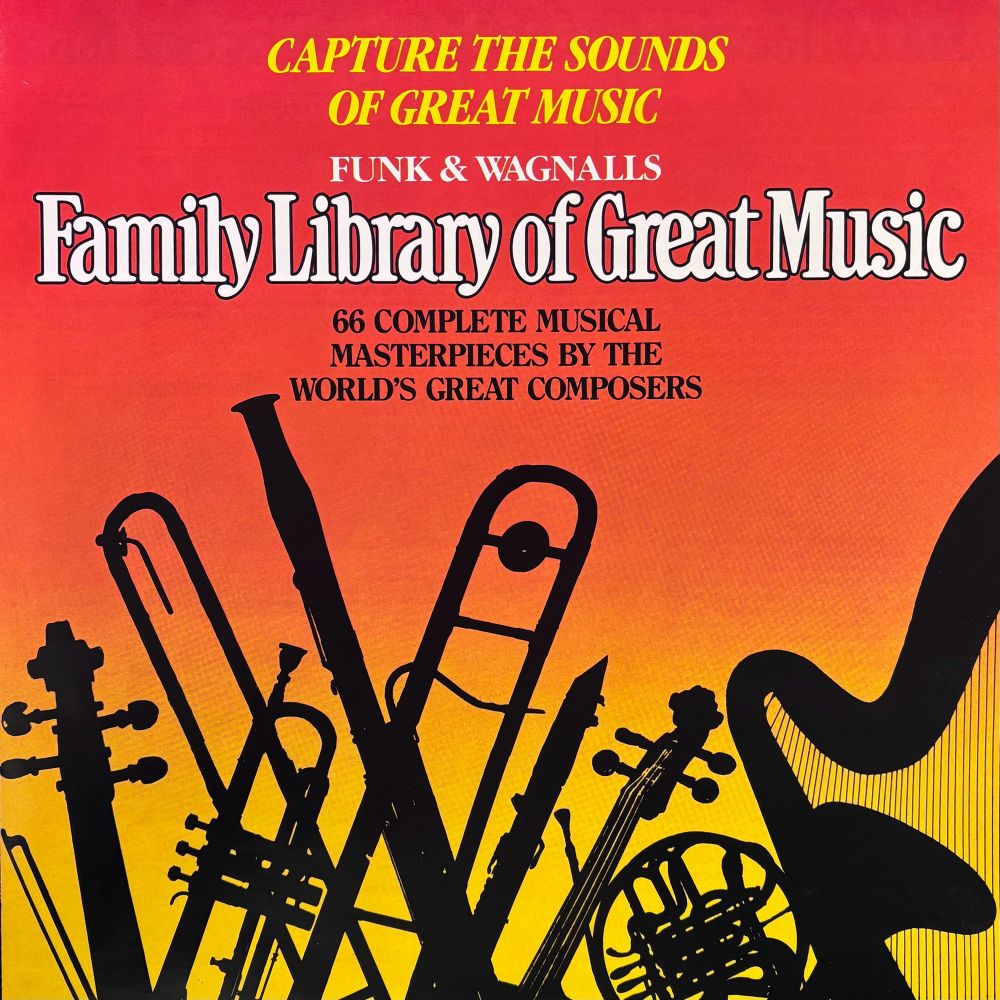
Cover of the included brochure for the library of 24 albums, bassoon prominently featured of course
Have you always wanted to Capture the sounds of great music? Well now thanks to Funk and Wagnalls Family Library of Great Music, you can!
I love finding things like this, especially ones with all the parts but I hate how tempted I am to track down all 24! More details in the alt texts
10.12.2024 21:13 — 👍 1 🔁 0 💬 1 📌 0
That’s exactly how I felt playing as 1/2 of a continuo unit with a modern bassoon!
09.12.2024 22:44 — 👍 1 🔁 0 💬 0 📌 0
Absolutely, the stuff of nightmares!
09.12.2024 20:31 — 👍 1 🔁 0 💬 0 📌 0
Lock me up if you want to but I think harpsichord sounds really dumb when paired with modern instruments.
No one’s more of a period ensemble girly than me (ok some of you probably are). But with a modern flute, bassoon, and tourte bows? it just sounds like a tinkly annoyance behind everyone.
09.12.2024 20:20 — 👍 3 🔁 0 💬 4 📌 0
I just finished traveling across the country by plane with a toddler in tow. This clarified something for me;
We should build high speed rail not because it'd produce far less pollution and be cheaper than flying.
We should build high speed rail because flying has become abusively degrading.
04.12.2024 07:46 — 👍 12 🔁 3 💬 1 📌 1
I'm not as funny as I think I am, but I make up for that with nudes
@holyhonedge pretty much everywhere if you wanna DM
https://linktr.ee/holyhonedge
He/him. Physically disabled. Canadian-American; fond of rye toast, when he can get it. Dreams a little.
Mayor-Elect of New York City
Demisexual, headbanger, belly rubber, barber, photographer, Pidove stan.
No LGB without the T, mf 🤟🏻🏳️⚧️
IG: https://www.instagram.com/sethrader/
OF: https://onlyfans.com/survivingheaven
Just trying to make someone smile
Writer, Podcaster, Game Designer | Friends at the Table | A More Civilized Age | Shelved by Genre | Formerly: Possibility Space, Waypoint, Giant Bomb, Paste Games
he/him. 18+. Pup Rudolf. 30 y/o midwest muscle bro. 1/2 human 1/2 dog. Good boy. Aries. FINDOM🔥💸👊🏻
Pup_rudolf on IG
Check out my brand
@goodboysonly.bsky.social
Tributes 👇🏻 Spicy Links 👇🏻
https://linktr.ee/squillbox
TikTok/Insta: @andy_mosity
Your online boyfriend 😊
https://onlyfans.com/kingjaxvip
https://linktr.ee/Jaximus
A NH wilderness model with a soft spot for
hiking boots, bare skin, and big views.
DM me for creative collaboration.
https://linktr.ee/NatureTwink603
Dedicated to the life and music of Academy Award-winning film composer Bernard Herrmann.
June 29, 1911 – December 24, 1975
Featuring updates on THE LIVES OF BERNARD HERRMANN, an upcoming documentary. Now filming.
Links:
linktr.ee/BernardHerrmannArchive
Seattle📍
Poet
Avid reader
Come to my bookclub!
Nintendo gaymer
Film enthusiast
#1 backbender
He/They
https://linktr.ee/noahsryan
🏳️🌈
Accelerating acceptance for LGBTQ people. 🏳️🌈🏳️⚧️
www.glaad.org/social
Founded in 1973, we are an organization of hundreds of thousands of LGBTQ+ people, parents, families, and allies—and hundreds of chapters—leading with love to support families, educate allies, and advocate for just legislation and policies. pflag.org
Help us build a people’s movement for bodily autonomy, self-determination, collectivism, and fulfillment.
Learn more at genderlib.org
We are the Northeast Ohio Socialist Rifle Association: https://linktr.ee/neosra
Your goofy uncle who fucks. Home: New York City.
The links: ShowOffJonah.com






![Stravinsky Histoire du Soldat [A Soldier’s Tale] ensemble info in alt text of next picture, album art depicts the soldier playing his violin attended by his gf, while the devil sneaks up behind him](https://cdn.bsky.app/img/feed_thumbnail/plain/did:plc:ab4byw6tdxki7lbbc6yzvr3g/bafkreigvjrpqh4dhoknfw5onfsspgzn7lrqy3am4r5ssimb464bnyuxaaq@jpeg)






